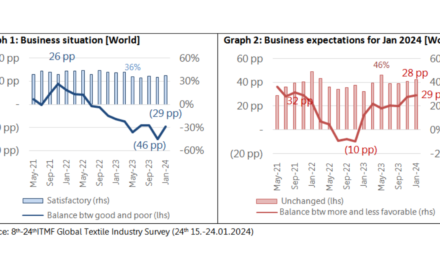 The textile and clothing industry in Europe was hardly hit by the pandemic in 2020. Now, it is time for the European Commission and its Member States to set the conditions for future competitiveness and resilience of industrial base, particularly the textile and clothing industry, EURATEX, the voice of the European textile and clothing industry, has said.
The textile and clothing industry in Europe was hardly hit by the pandemic in 2020. Now, it is time for the European Commission and its Member States to set the conditions for future competitiveness and resilience of industrial base, particularly the textile and clothing industry, EURATEX, the voice of the European textile and clothing industry, has said.
“The textile and clothing (T&C) industry is a pillar of Europe with its savoir-faire and excellence, counting 160,000 companies (mainly SMEs), employing 1,500,000 people, generating €162,000 billion. 38 per cent of such industry’s turnover is sold on global markets, whereby SMEs cover more than 50 per cent of those global sales,” EURATEX said on the occasion of EU Industry Days.
In order for the European Commission and Member States not to lose such asset, EURATEX has suggested a series of measures. First, Europe should put in place effective market surveillance, avoid unfair competition and guarantee level playing field. The continent has the stringiest social and environmental standards, and it should protect the quality of its products. We hear too often that products made in other countries do not attain these standards, such is the case of non-complainant face masks, and it is time to act upon it.
Second, Europe should support the transition towards a more sustainable and digital industry through specific funds and programmes. Indeed, SMEs, due to their size and capacities, do not have the power to innovate their products and processes in the short-term. Moreover, the sector should reduce future risks by diversifying its supply chains and promoting nearby production. Europe can again play a fundamental role in the development of a new trade policy.
Third, Europe should have a market proof approach when moving towards sustainability and circular economy. The green transition should carefully balance the cost of this transition process and the long-term benefits. The green and digital transition is challenged by the economic crisis. Business and citizens may rapidly loose interest if the transition does not provide any short/mid-term benefit.
Fourth, Europe should help education systems and institutes to develop comprehensive and leading-edge T&C knowledge. It can do so through LongLife Learning, Erasmus + and the Pact for Skills Initiative. “Our industries suffer from an aging workforce and it is fundamental to reskill/upskill it. Most importantly, the sector should attract young generation to renew itself and drive the change,” EURATEX said.
Lastly, Europe should have a coherent approach when legislating in different areas. “All policies, from the Green Deal to the Sustainable Chemicals strategy, from the EU Trade strategy to the EU Industrial one, should be consistent and not hamper industry. If not, consequences will be fatal.”
“The forthcoming Textile Strategy for Textiles represents a terrific opportunity for industry and policy makers to develop a forward-looking vision,” said EURATEX Director General Dirk Vantyghem. “If Europe misses this chance, it risks losing one of the essential ecosystems. Too many sectors will be affected by such loss, as textiles are everywhere, from a car to the street we walk on.”





















